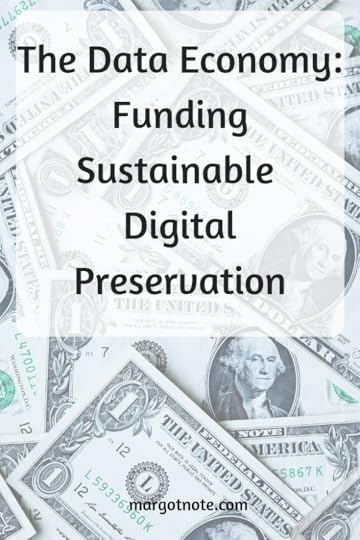Margot Note's Blog, page 35
April 22, 2019
Shifting Concepts of Preservation in a Digital World
As our understanding of digital preservation, curation, and stewardship matures, archivists and other information professionals have begun to question some of our assumptions about preservation. To address current needs, the practices we have developed and taken for granted for decades are transforming in the digital environment.
In this new era, we are creating principles that apply to digitized and born-digital materials, while continuing to acquire, store, and provide access to physical records of enduring value.
New ParadigmsThe volume, variety, and velocity of the digital revolution, along with its technical challenges, add additional complexity to archival practice. Digital preservation has transformed the procedures of archivists and information professionals. Many preservation methods we have used with physical materials no longer translate into the methodology of preserving digital resources—requiring us to create new ways of thinking about saving history.
No Going BackFor example, preservation practice traditionally dictated that treatments should be reversible whenever possible. A handwritten letter is encapsulated in an archival-quality plastic enclosure, from which it could be easily removed. We would not laminate the letter (as was sometimes done in the past) because the process was irreversible and, over the long term, damaging.
In our contemporary times working with digital materials, we sometimes must make changes that are irreversible. We migrate digital files to new formats when the older formats are unusable; we emulate computer programs when the equipment and software are no longer available. These transformations make information accessible in a new format, hopefully without constraining its original functionality. There is no going back because there’s nothing to return to.
Originals and CopiesOur concept of originals has also changed. For physical materials, the originals should almost always be preserved. We traditionally only reformatted items that were untreatable as a last option. For example, microfilming and photocopying were used for reformatting to improve ease of access and to decrease storage space.
For digital materials, the information content is what is important, not necessarily the carrier, like a floppy disc. Copying as a strategy for preservation is nothing new, yet the complexity of copying digital objects presents fresh challenges. While microfilm exchanges paper for film, multifaceted digital files require careful migration and emulation practices.
Neglect No MoreBenign neglect, the idea that noninterference would benefit collections more than continual attention would, has also been reevaluated. As archivists, we’ve all examined closets filled with boxes of paper files that haven’t been touched in decades. For the most part, physical materials do not deteriorate rapidly if ignored, thus buying time before preservation attention is needed.
Digital objects, in contrast, face file formats that become obsolete, are stored on media that deteriorates, and rely on hardware and software that may no longer be available. Benign neglect has never been an option for digital materials. Digital information has to be actively managed over time, starting from the moment of creation.
Evergreen PrinciplesDespite the differences in preservation for analog and digital materials, some perennial practices still are applicable, no matter what the object. For instance, appraisal of collections will continue to be necessary, due to limited resources. Determining the best materials of enduring value also allows for high-quality collections. All materials have what is known as inherent vice, the tendency to decay. To understand preservation, we must understand the structure of the materials—whether they are made of cellulose fibers or bits and bytes. As always, archivists will also continue to address information at the collection level, rather than as individual objects.
Preservation NowMore importantly, analog or digital preservation always considers the needs of patrons, since collections are preserved to be used. Taking preservation action now, rather than later—especially for digital materials—helps ensure the survival of research materials for our users. By identifying, preserving, and providing access to documentary heritage regardless of format, we sustain cultural heritage for the next generation.
The blog was originally published on Lucidea's blog.
If you like archives, memory, and legacy as much as I do, you might consider signing up for my email list. Every few weeks I send out a newsletter with new articles and exclusive content for readers. It’s basically my way of keeping in touch with you and letting you know what’s going on. Your information is protected and I never spam.
Follow me on Pinterest | Instagram | Twitter | LinkedIn | Facebook
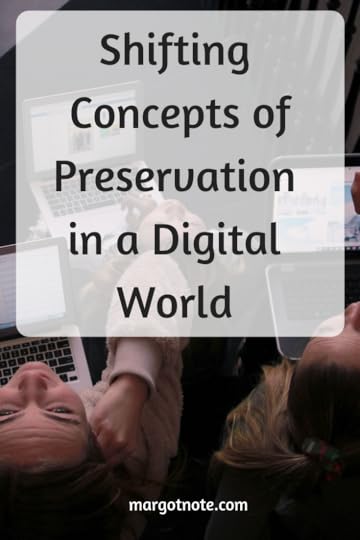
April 15, 2019
Active Learning Strategies
Active learning means understanding the subject matter your studying through different activities. The efforts allow you to evaluate the content rather than just memorizing the theory.
Getting ActiveActive learning techniques become easier through regular use. Experiment with different methods to see which ones feel more natural than others.
Some ApproachesCreate a mind map of a topic, linking ideas and information.
Simplify your notes to make them easier to read. Can you condense what you're learning into short statements?
Discuss thoughts and ideas with others.
Imagine you were explaining a concept to someone unfamiliar with it. How would you describe it?
Draw a sketch to illustrate a concept or idea.
Create a chart or diagram.
List bullet points of key concepts.
Write key points on index cards and move them around. How can you relate the concepts to each other?
Summarize a passage in 50 words. Try ten words.
Pretend to disagree with what you’re reading. Think of arguments for both sides.
Link your studies. How does one subject you’re learning relate to your other subjects?
Make it practical. How can what you’re learning relate real-life examples?
What strategies do you use to actively learn? Let me know in the comment section below.
Follow me on Pinterest | Instagram | Twitter | LinkedIn |
If you like archives, memory, and legacy as much as I do, you might consider signing up for my email list. Every few weeks I send out a newsletter with new articles and exclusive content for readers. It’s basically my way of keeping in touch with you and letting you know what’s going on. Your information is protected and I never spam.

April 8, 2019
How to Save Your Life
As you reflect on your life, what moments or thoughts would you like to save? What about some of your family members? Wouldn’t you like to record their opinions on their lives?
Open-ending questions about people’s life experiences yield surprising results. Use these questions to record your thoughts, or start a conversation with a relative. When possible, record the interview on audio or video.
Questions to Save Your LifeWhat everyday conveniences do we have today that were not available when you were a child/teenager/adult?
What were the significant issues and worries that faced you then? How were they different than today’s problems?
What world events affected your life the most? Why?
Were you as aware of the events in the world as we are today?
What were your major concerns for the future?
What were your dreams or expectations for the future? Which came to pass? Which didn’t?
What events in your life, if any, caused you to change your expectations or goals? Were the changes for the better or do you have regrets?
Do you think it was easier then or now to reach the goals we set for ourselves? Why?
If you could go back in time, knowing what you know now, what, if anything would you change? Why?
What was the most rewarding time or event in your life? Why?
What piece of advice would you like to give me?
Go DeeperIf you’re interested in asking even more questions, download my oral history kits:
300+ Personal History Questions Workbook
Family History for Mothers Kit
Family History for Fathers Kit
50+ Halloween Memory Questions
What questions would you add to this list? I’d love to hear them in the comments below.
To learn the preservation secrets used by libraries, archives, and museums to protect their priceless materials (that you can also use for your family heritage items) read my book:
Creating Family Archives: How to Preserve Your Papers and Photographs
By Margot Note
Ready to get started creating your family archives? Here are some of my favorite products:
Follow me on Pinterest | Instagram | Twitter | LinkedIn | Facebook
Like this post? Never miss an update when you sign up for my newsletter. As a gift to you, you'll receive a free, premium download of my Project Prioritizer. This trusted tool will help you embrace where you are with your collections and start enjoying your family archives more today.


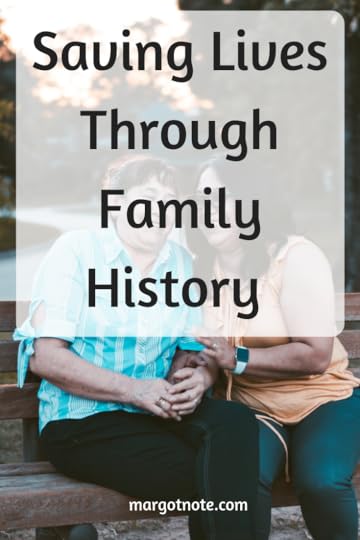
April 1, 2019
Reading Critically
When you’ve identified a source that’s of interest and relevance to your research, you should subject it to critical evaluation. As you review it, ask yourself why the work was needed, what its analysis was, and how the authors interpreted the results. Most importantly, what’s your interpretation of the results?
Since research requires reading from multiple sources, be clear about what you’re looking for and where to find it.
Read In Order of ImportanceReading papers straight through from start to finish is a poor use of time and won’t aid your understanding of the work. Some sections of an article are more important than others. Here’s a suggested order for reading sections of a humanities paper, for example:
Start first with the abstract. This paragraph condenses the significant points of the article and lets you decide if you should continue reading the rest of the findings.
Move to the introduction. This section lays out more details. Have the authors described the general and specific background of their results adequately? What is the question that is attempted to be answered in this paper? Is the article now in context?
Jump to the section that discusses the results or findings. For the critical reader, the results section is the most crucial part of the paper as it presents the facts. Do you agree with the authors’ approach? Does anything seem odd or require further exploration?
Move on to the discussion or analysis section. How have the authors interpreted their findings? Do you agree with the arguments they have made?
Examine the methodology section. Given what you already know, do you agree with the methods used?
Next, peruse the literature review. This section tends to be extended. Are their section headers that group related concepts? What questions or comments does this section spark?
Skim the Conclusion. What future research is needed? Has the overarching question of the paper been answered?
Finally, look at the Bibliography or Works Cited. Are their important papers or authors missing from this paper? Have you discovered new papers to evaluate?
Skills You Employ as a Critical ReaderAs you review the sections, you employ a range of skills:
Analysis: Is the paper well structured? Does the evidence support the argument? Do the authors make assumptions?
Comparison: How does the article relate to other works in the same field?
Comprehension: What is the main point of the paper? Are the authors clear?
Consolidation: How do the authors come to their conclusions? How do you draw your consultations form the results?
Evaluation: Is the work quality research?
Interpretation: Do the authors’ conclusions follow from the results or do you have a different view?
Of course, some of these answers become easier with experience, but these approaches make a good starting point in the context of critical reading.
How do you read critically? Let me know in the comment section below.
Follow me on Pinterest | Instagram | Twitter | LinkedIn |
If you like archives, memory, and legacy as much as I do, you might consider signing up for my email list. Every few weeks I send out a newsletter with new articles and exclusive content for readers. It’s basically my way of keeping in touch with you and letting you know what’s going on. Your information is protected and I never spam.

March 25, 2019
Giving and Receiving Feedback
Feedback provides information and advice. It’s offered in a variety of settings, such as part of your supervision, during presentations at conferences, while teaching or learning, or when working as part of a team. Whatever the environment, feedback is a highly productive way of developing yourself and your skills.
However, it’s important to give and receive feedback in the right way and in context. In most circumstances, it’s best to approach feedback from the perspective of kindness and empathy. As humans, we can hear a 100 positive comment, but that one negative (and mean) one will stick with us. The message of the adverse comment may be something important to know, but its delivery makes us either question the giver’s intent or makes us defensive. Constructive criticism should be constructive; that is, useful. In professional circles, I’ve witnessed and received some frightfully unprofessional feedback. Be kind or be quiet, I say.
Giving FeedbackHere are some guidelines to follow when providing feedback:
Above all, be motivated by the desire to help; always consider the value of what you’re saying to the person receiving the feedback.
Give personal feedback face to face, never by email. Difficult conversations deserve to be had in person and in private.
Offer feedback on what you directly know or have seen; avoid incomplete or second-hand information.
Limit yourself to the most essential points.
Ask questions when appropriate, rather than make statements.
Let the person know in advance, if possible, about the feedback. Don’t surprise them.
Feedback should be timely and as close in time to the event to which it relates.
Highlight areas where the person did well, as well as areas of improvement.
Some people suggest placing negative feedback between two pieces of positive feedback (popularly known by this euphemism). Many find this approach patronizing and prefer straight talk.
Be concise and specific.
Give the other person the opportunity to respond.
Receiving FeedbackAs much as possible, be open to constructive criticism and to compliments. Sometimes negative feedback, delivered professionally, is life changing.
Years ago, I worked for a Director of Development Operations at a small, private college. She invited me into her office once and took me to task on several things I needed to improve. She delivered strong feedback in a stern, dignified way. I remember not being upset or angry, but thinking, “Wow, she’s exactly right!” I gained so much respect for how she handled the situation that I immediately wanted to rectify the problems. That’s the power of well-received feedback.
When receiving feedback, follow these guidelines:
Avoid being defensive; allow others to be honest and give them the opportunity to be heard.
Stay focused and listen closely.
Ask questions to help clarify comments.
Acknowledge valid points.
Take time to think about what you hear. You don’t need to respond in that moment, especially if you are emotionally charged. Give yourself some time to process the feedback.
If appropriate, return to the person giving feedback with suggestions or ideas about specific points raised.
If you’re the subject of particularly negative or weird feedback, ask yourself if the person delivering it is motivated by the desire to help. Or is something else going on instead? Trust your gut. Feedback is never an opportunity for abuse or “negging.” Sometimes people are just jerks.
What are your experiences with feedback? Do you have suggestions to add to the guidelines I’ve outlined? I’d love to hear them in the comments below.
If you like archives, memory, and legacy as much as I do, you might consider signing up for my email list. Every few weeks I send out a newsletter with new articles and exclusive content for readers. It’s basically my way of keeping in touch with you and letting you know what’s going on. Your information is protected and I never spam.
Follow me on Pinterest | Instagram | Twitter | LinkedIn | Facebook

March 18, 2019
Scalability of Digital Preservation: The Right Fit for All
As with many archival projects, large institutions lead the way to new discoveries, workflows, and practices. Discussions about digital preservation have been too frequently (but understandably) presented in terms that apply only to large, well-funded institutions.
These organizations tend to have more resources to apply to digital preservation. A state university, for example, may have an archives and manuscripts section or special collections department that consists of multiple people, can employ an inexpensive labor force of work-study students, and, in some cases, has professors and graduate students focused on solving preservation problems.
Often, best practices developed in these settings are unrealistic to apply to other institutions with fewer resources; the pioneers of these procedures may have little regard for the requirements of small organizations or individuals. Additionally, even the preservation tools employed by well-resourced organizations can be challenging and expensive. How can smaller, resource-constrained archives apply cost-effective tools and technologies for preservation?
Right-sizing for Collections and ResourcesThe challenge facing archivists is to scale digital preservation efforts to the size of the collections, without compromising data integrity or system performance. Archival repositories need scalable and context-aware preservation planning and monitoring capabilities to ensure continued accessibility of content over time. The issue confronting institutions is to enable digital preservation to adjust labor and costs at a time when the production of content is mounting, yet budgets aren’t commensurate with the volume of content in need of safeguarding. For digital preservation to be accessible, each process and component involved needs to provide scalability.
Big Needs for Smaller OrganizationsWhile smaller institutions such as historical societies, cultural organizations, town and county records offices, and colleges vary in their materials and missions, they share similar characteristics. Their staff members have diverse duties, with limited time and resources. Archivists at these institutions don’t have the resources to install complicated software or subscribe to preservation services, but they still have a mandate to collect and preserve born-digital records. They need precise instructions that can be readily implemented. The challenge is to translate the lessons learned in larger institutions to guidelines and actions for smaller institutions. Digital preservation must be scalable—that is, the field should offer solutions that work at institutions large and small.
Open Source and Free SoftwareOften digital preservation workflows are ad-hoc in smaller institutions, using open-source and free software to convert files for access, check for viruses, create checksums, and store files safely. There are several reasons why archives might be attracted to the idea of open source, such as support from a community of users, the promise of free downloads and licenses, or the availability of source code for modification. Yet, these free and open source software options often require hidden resources to implement and use. The successful utilization of open source software to solve day-to-day operational challenges related to preservation and access necessitates a lot of hands-on work. Free and open still requires labor.
In my experience as a lone arranger using an open source solution, I found that the amount of time and resources devoted to setting up the system and getting comfortable with it was overwhelming. I might have been better served by a commercial database with training tools and customer service. Of course, the solutions depend on the organization; an option that works at one institution may not work at another.
Personal Digital ArchivingHow we archive our personal digital materials has become a topic of scholarly investigative and advocacy initiations. Personal digital archiving is a relative newcomer to the digital preservation field and poses new challenges, especially with the proliferation of new digital tools.
The phrase “personal digital archiving” can be interpreted in different ways, but it usually applies to digital preservation at the individual level as opposed to the institutional level. Yet, the publications, blog posts, and conference topics devoted to personal digital archiving discuss individuals and families interesting in saving their digital files and academics preserving their digital work, as well as local history and genealogy groups dealing with the influx of digital material, and community groups acquiring digital collections from the communities they serve. Personal digital archiving seems to be fulfilling a need to explore options and inform those who are working with smaller collections.
No Quick SolutionsIn the future, archivists and other information professionals will determine a scalable digital preservation solution—or more realistically, a series of solutions. There’s a desire for a quick, simple tool to solve all digital preservation problems, but that’s unrealistic. No answer will replace the work of making decisions about which records have enduring value and significance to our institutions. A viable preservation program addresses organizational issues, technological concerns, and funding questions to provide good stewardship for digital records. The discoveries made in personal digital archiving, coupled with the best practices of larger institutions, may provide smaller cultural heritage institutions with the solutions they need over time. As archivists, we can document our decisions today so that repository managers who inherit the outcomes of our work will be able to carry these objects into the next generation of sustainable, scalable digital preservation solutions.
The blog was originally published on Lucidea's blog.
If you like archives, memory, and legacy as much as I do, you might consider signing up for my email list. Every few weeks I send out a newsletter with new articles and exclusive content for readers. It’s basically my way of keeping in touch with you and letting you know what’s going on. Your information is protected and I never spam.
Follow me on Pinterest | Instagram | Twitter | LinkedIn | Facebook
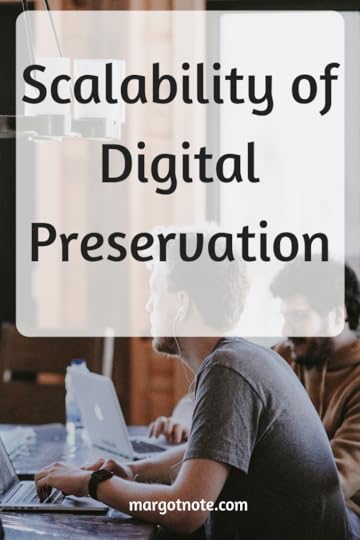
March 11, 2019
Skills Building for Digital Preservation
The archival field lacks people with the expertise needed to extend the digital preservation agenda. Formal training opportunities for digital preservation are still rare, so much is learned on the job. New archivists may be uncertain as to where to acquire specific skills, and seasoned archivists need to broaden their knowledge or expand their roles professionally.
Training to meet these needs most often occurs outside of institutional educational settings, relying on the learner’s ability to locate free or low-cost resources. Efforts to understand and meet training and skills needs for the preservation, management, and handling of data are burgeoning, with significant work underway.
Needs Assessment for Technical SkillsTraining needs surveys have attempted to gather information to pinpoint current and anticipated skills needed for digital preservation. For example, the Digital Archiving and Preservation Training Needs Survey was developed in collaboration with the Digital Curation Centre (DCC), Digital Preservation Coalition (DPC) and University of London Computer Centre (ULCC). The three organizations have worked collaboratively with the aim of promoting best practices and providing training on the long-term preservation and sustainability of digital content.
Increasingly, there has been investigation about the skills required, including the DigCCurr (Digital Curation Curriculum) project, which produced a detailed listing of the skills and competencies needed. The SHERPA Project (Securing a Hybrid Environment for Research Preservation and Access) identified nine skill categories: management; software; metadata; storage and preservation; content; advocacy, training, and support; internal liaison; external liaison, and current awareness and professional development. DigCurV created a curriculum framework for digital curation that can be used to develop new training resources and to identify skill gaps. The project examined three levels (practitioner, manager, and executive) and indicated digital curation skills and competencies and pathways of skills progression.
Training OpportunitiesWebinars, workshops, summer schools, and other educational opportunities dedicated to digital preservation are on the rise. For example, Digital Preservation Management: Implementing Short-Term Strategies for Long-Term Solutions is an online tutorial that examines many concepts and elements of digital preservation.
Training assists archivists to keep current in a constantly changing landscape. Digital preservation work requires that practitioners stay up-to-date with formats, software, and standards. Materials on digital preservation help learners familiarize themselves with topics, gain confidence, and develop the skills they need to start working with digital collections. These materials support common practices and vocabularies that strengthen the digital preservation community; they provide continuity within a constantly shifting environment.
Formal educational programs dedicated to managing digital material are increasing as well. Resident programs—such as the National Digital Stewardship Residences in the United States—allow practitioners to develop and advance digital stewardship skills in real-world settings.
Some of the larger digital preservation research projects have included educational elements. The International Research on Permanent Authentic Records in Electronic Systems (InterPARES) 3 Project, for example, developed teaching modules for use in training programs, continuing education workshops, and curricula. The goal of the training is to provide professionals with the competency to preserve digital heritage and protect its accuracy and authenticity. The PERICLES project (Promoting and Enhancing Reuse of Information throughout the Content Lifecycle taking account of Evolving Semantics), funded by the European Union, produced a series of online, self-instructive, stand-alone modules.
Influencing Data CreationIncreasingly, it will also be necessary to educate the creators of digital materials about preservation so that they apply appropriate standards at the beginning of their projects. Creating digital assets with preservation in mind will be helpful in making lasting materials that require less intervention. The need to educate creators about issues and techniques to address them is ongoing.
General Professional SkillsGeneral skills are needed at a high level to provide a deep understanding of the reasons why preservation is required. High-level capabilities, such as project management, presentation skills and advocacy are needed, as well as technical skills. For example, the Digital Archiving Preservation Training Needs Survey highlighted interest in planning skills, such as organizational change and advocacy, collaboration, and strategic thinking. While training resources exist in these areas, the field of digital preservation has unique possibilities and challenges that require additional professional context. Training that supports strategic planning and digital preservation can fulfill this need.
Skillsets for SuccessDespite the progress in recent years, the challenge of meeting the need for education and training in digital preservation is still high and will take many years to address comprehensively. Archivists and other information professionals continue to look for digital preservation training and professional development opportunities that enable them to perform their jobs confidently—with the right information and skills to make decisions that affect digital heritage in the long term.
As the field defines and codifies techniques for digital preservation, action should be taken now. Learning preservation techniques will optimize current access while also planning for the long term.
The blog was originally published on Lucidea's blog.
If you like archives, memory, and legacy as much as I do, you might consider signing up for my email list. Every few weeks I send out a newsletter with new articles and exclusive content for readers. It’s basically my way of keeping in touch with you and letting you know what’s going on. Your information is protected and I never spam.
Follow me on Pinterest | Instagram | Twitter | LinkedIn | Facebook

March 4, 2019
Final Revision Checklist
The underlying quality of thought and the argument you put forward in an essay matters. By the time you near completion of a paper or thesis, you should put aside some time to review a number of elements in your writing. As you perform your final revision, ask yourself the following questions:
ConstructionDoes the introduction properly set up your argument?
Are the stages of your argument clearly signaled with language or sections?
Does the concluding section show how the question has been answered?
LanguageAre you clear in your writing?
Are you succinct? Are there unnecessary passages that could be culled?
Have you spelled out the abbreviations you’ve used?
Have you removed colloquialisms?
Are your sentences expressed clearly, with no awkward phrasing?
Can you make any passages more concise?
Are your punctuation, spelling, and grammar correct?
FormatIs the paper length within the prescribed limits?
Is there a clear layout?
Are the pages formatted correctly, with adequate margins, page numbers, and indented paragraphs?
SourcesIs your evidence identified and distinguished from interpretation or judgement?
Is your evidence documented with sources?
Was the best available evidence consulted?
Are your Internet sources reliable? Do they have an academic authority or useful primary source evidence?
Are all sources properly set out in quotations and cited? Is there any possibility of inadvertent plagiarism?
Are quotations aptly chosen?
Is each quotation (in-text or block) properly introduced?
FootnotesIs all your evidence documented?
Is there any avoidable strings of Ibids?
Do your footnotes cite sources that you have actually read, not just seen cited elsewhere?
Is the citation format correct and properly followed?
Are exact page numbers included?
For websites, have you included full citations, not just URLs?
Have you included DOIs, if available?
BibliographyIs the bibliography well-laid out and organized alphabetically by last name?
Is all the prescribed information in the right sequence, according to the citation format you used?
The final revision of your paper, with consideration to these questions, will help shape your efforts into quality scholarship.
What are additional questions you ask yourself as you revise?
Follow me on Pinterest | Instagram | Twitter | LinkedIn |
If you like archives, memory, and legacy as much as I do, you might consider signing up for my email list. Every few weeks I send out a newsletter with new articles and exclusive content for readers. It’s basically my way of keeping in touch with you and letting you know what’s going on. Your information is protected and I never spam.

February 25, 2019
Getting Unstuck
If you’re looking for a new job or happily employed, there are moments in your professional life when you feel immobile, despite your best efforts. Here are a few pointers for getting unstuck.
MariKondo Your LifeIn the bestselling book The Life-Changing Magic of Tidying Up: The Japanese Art of Decluttering and Organizing, Marie Kondo suggests getting rid of anything that doesn’t spark joy. This, of course, pertains to not only your house, but to your career. What can you declutter from your resume, office, and desktop—virtual or physical? This concept also translates into professional commitments. What activities can you stop doing, improve upon, or delegate?
Always Be ClosingAs Alec Baldwin’s character asserts in the 1992 film Glengarry Glen Ross, always be closing. How does this pertain to the information fields, you ask? Think about projects and tasks that you can finish. What has been lingering on your to-do list that you’d love to complete? Then commit your time to finish it. Assign yourself one task that you will prioritize for the day. Focus on it with Jedi-like precision, and you will feel the victory of progress.
Feel the PainWhat action are you dreading? Do it before all others. Often it’s just a matter of getting started. Use the Pomodoro technique; many free apps are available. Using a timer, work for 25 minutes with a five-minute break. For particularly heinous tasks, promise yourself that you only have to do one Pomodoro’s worth of work. Once you start, you’ll usually want to continue. Even if you don’t, you’ll be surprised by how much was accomplished during that period of constant activity.
Procrastinate Like a ChampOr do the opposite and harness the power of procrastination. If you have something that you must do, put it off by accomplishing smaller tasks. Keep track of your to-do list with the role-playing productivity game Habitica (a personal favorite) or good old-fashioned pen and paper. While the main activity won’t get done until later, you’ll do all the things you needed to do anyway while whittling away your excuses for not focusing on your primary task. When the other responsibilities are done, your only choice will be to work on your main assignment.
Reach OutBe a person of action, and think about ways in which you can re-engage with the field. What book, podcast, or blog post should you check out to keep up with the profession? Attend the next professional event in your area. Sometimes institutions host tours of their facilities or overviews of their projects. Often they are organized by local professional associations, but you can go on personal tours if you reach out to someone at the organization. You’ll be surprised by the generosity of your fellow librarians and archivists.
Mine Social MediaSearch LinkedIn for career information. Look at people with jobs you’d like to have. What have they done that you can replicate? If you find someone in particular who has a path that interests you, ask them about their career trajectory. Research organizations with positions or departments that appeal to you. Follow them on social media to get updates on their activities and to find ways to engage with them.
Write ProfessionallyContact journals for book review opportunities. Many journals are looking for reviewers, and the requirements for entry as a reviewer are low. You’ll be reading what you should be reading anyway, for free, and will contribute to the profession by offering your opinions on the topic. Contribute to a blog or start a blog yourself. And don’t forget to consider writing for LinkedIn! That’s how I just got unstuck.
If you like archives, memory, and legacy as much as I do, you might consider signing up for my email list. Every few weeks I send out a newsletter with new articles and exclusive content for readers. It’s basically my way of keeping in touch with you and letting you know what’s going on. Your information is protected and I never spam.
What do you do to get unstuck?
Follow me on Pinterest | Instagram | Twitter | LinkedIn | Facebook
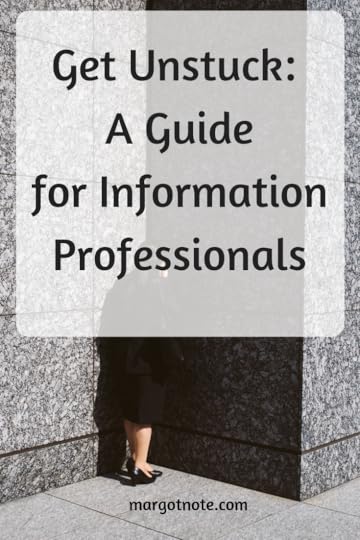
February 18, 2019
The Data Economy: Funding Sustainable Digital Preservation
The Information Age spawns questions for the future. How will we ensure long-term access to information, growing exponentially every day? How will we migrate data as technology moves from one medium to the next? Who determines what’s saved, and what criteria will be used to make those decisions? Most importantly, what is the cost of preservation? Who will pay for it?
Cash is KingEconomic sustainability for digital preservation is challenging. Digital preservation is vulnerable unless it becomes a part of core business activities and its funding becomes an operational expense, rather than a project-based one. Only continual, reliable financing can make digital preservation possible.
Digital preservation is also expensive. It requires hiring full- or part-time staff members who have the required skills. It demands technical infrastructure, which can be costly to purchase, operate, and replace. Digital preservation necessitates new models for channeling resources to preservation activities, affordable efforts—and recognition by decision-makers for the need to preserve with catalysts that spur action.
Initial Funding InquiriesThe lack of information about how much digital preservation costs impedes the securing of ongoing funding. Inquiries into expenses began in earnest in the 2000s. For example, the Blue-Ribbon Task Force on Sustainable Digital Preservation and Access was funded by the National Science Foundation and the Andrew W. Mellon Foundation, in partnership with the Library of Congress, the Joint Information Systems Committee of the United Kingdom, the Council on Library and Information Resources, and the National Archives and Records Administration. The task force investigated digital preservation from the perspective of economic sustainability by determining costs and identifying sustainable economic models that could ensure the availability of resources for preservation activities.
Its final report, issued in 2010, provides principles and actions to support enduring economic sustainability; context-specific recommendations regarding organizational, technical, public policy, and educational and outreach activities, and next steps for the field. The task force found that sustainable digital preservation requires a compelling value proposition, incentives to act, and well-defined roles and responsibilities. Additionally, organizations need to be flexible to adjust to changing preservation priorities.
Beyond Cost-ModelingThe 4C Project, the Collaboration to Clarify the Costs of Curation, was created to help European institutions invest more effectively in digital preservation. The focus of the project was to move away from more traditional cost-modeling to see where existing work and tools can be made more relevant and usable for a wide range of organizations. The project, which took place from 2013 to 2015, produced various tools and models, including a Digital Curation Sustainability Model, an Economic Sustainability Reference Model, and the online Curation Costs Exchange. While the project concentrates on organizations in the European Union, the tools can be used to create new cost-effective solutions and services on a global scale.
Cost BenefitsOften when organizations expand their activities in ways that require additional resources, executives will request a business case that outlines cost benefits. A business case offers a roadmap both to understanding a current situation and moving towards a future state regarding digital preservation. The case should describe the funds needed, how the resources will be deployed, and how the investment will benefit the institution.
The Digital Preservation Coalition’s Digital Preservation Business Case Toolkit, for example, assists practitioners and managers to build business cases to fund digital preservation activities. The toolkit outlines an executive summary, the strategic vision, the context of the organization and its assets, the business activity, and the return on investment.
Creating a Business CaseWhen developing a business case, analyze the existing environment and the organization’s requirements, and then set priorities. You’ll also want to ensure the solution you’re promoting is a good fit for your organizational culture. The more easily the proposed solution can be integrated into current routines, the more likely it will be accepted.
Business cases, most importantly, focus on economics. How will digital preservation demonstrate a cost benefit over time? How will preservation save money or make the organization more efficient? Costs can be gauged in dollars, but also in staff time and other resources. Consider the use values of digital preservation too. The more your patrons can utilize data, the more value it has. Use value provides a strong argument for longstanding digital preservation. Look for partnerships to share the economic burden. Is there an opportunity to collaborate with organizations in a similar position or share similar goals? Is there a way to share costs?
Justifying the Costs of Digital PreservationSecure digital materials form part of our enduring scholarly and cultural record. Continuous access to digital content requires sustainable digital preservation activities. To advocate for these activities, archivists should frame digital preservation as a viable economic activity that necessitates both a deliberate allocation of resources and ongoing resource allocation over time. Materials are essential data assets that provide value and require money to save. Gone are the days of only project-based funding for digital preservation in archives. Economic sustainability secures adequate resources to achieve long-term goals, reduces financial risks to digital assets—and requires investment.
The blog was originally published on Lucidea's blog.
If you like archives, memory, and legacy as much as I do, you might consider signing up for my email list. Every few weeks I send out a newsletter with new articles and exclusive content for readers. It’s basically my way of keeping in touch with you and letting you know what’s going on. Your information is protected and I never spam.
Follow me on Pinterest | Instagram | Twitter | LinkedIn | Facebook
